Tommy Emmanuel’s percussive, expressive style of playing, perfected over decades, has earned him a devoted following. He is frequently cited as one of the greatest living acoustic guitarists, if not one of the best all-time. Unsurprisingly for someone of his virtuosic ability, Tommy’s musical career started at a very young age.
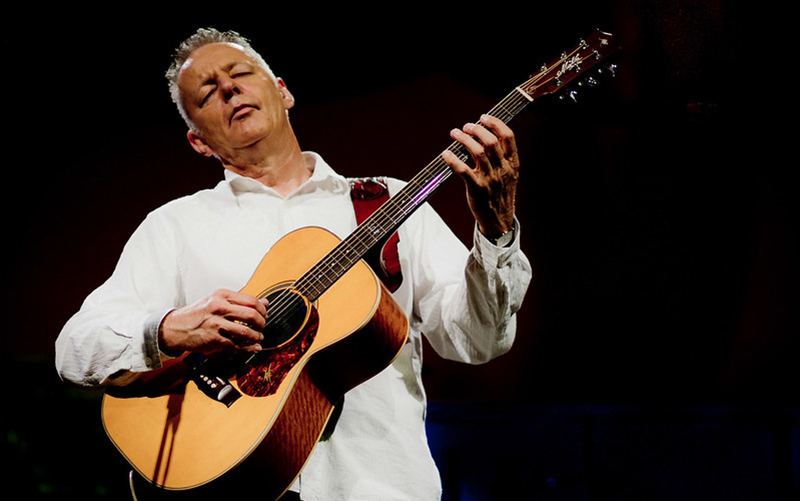
Emmanuel, an Australian, was a small boy living in Muswellbrook, a thoroughly unassuming town in regional New South Wales. Although he was two and a half hours from Sydney, and plenty more from Nashville, he heard Chet Atkins and his revolutionary Travis picking style on the radio at the age of six. Despite his youth, he quickly picked up the guitar and, along with his brother Phil, progressed on the instrument in leaps and bounds. Their father, taking note of the boys’ massive talent, sold their home, started a family band, and took the Emmanuels on the road.
Decades came and went, and years after he was missing school and writing to his hero Chet Atkins. Nevertheless, his efforts proved fruitful, as he was eventually appointed a member of the Order of Australia. He played the Sydney Olympics, and Chet Atkins eventually declared Tommy “one of the greatest guitar players I’ve ever seen”.
What Guitars Does Tommy Emmanuel Play?
Tommy Emmanuel plays a Maton acoustic guitars, most notably his EBG808TE and TE1 models. In 2020, Tommy teamed up with Larrivée Guitars on a single cut C-03-TE model. While Tommy is most known as an acoustic player, he also plays a 1966 Fender Telecaster for electric work.
See the full list of Tommy Emmanuel guitars and gear below.
Maton EBG808TE
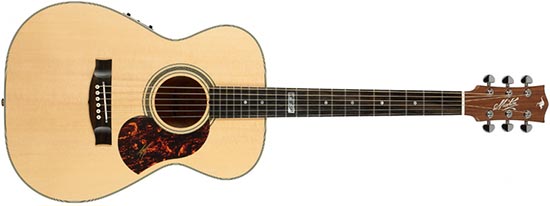
| Finish | Natural |
| Years Used | 2008 to Present |
Although today he is a proud American citizen, Tommy Emmanuel, as the song goes, still calls Australia home. Accordingly, he is most frequently associated with the fine acoustic guitars built by the Australian manufacturer, Maton, for whom he has become something of an international ambassador. Tommy Emmanuel has played Maton guitars for most of his career, and to this day he is best associated with this signature model, built to the highest standards in order to suit all his needs.
Even though Maton guitars may not be the biggest mainstream name in the industry, these are certainly some of the highest quality string instruments in the market. Founded in 1946 by brothers Bill and Reg May, hence the name.
Back in the 1950s, Australia had strict tariffs on imported goods. That meant that the iconic Gibson and Fender guitars that were dominating the entire musical landscape in the US and UK were inordinately expensive. The May brothers sought to address the needs of Australian musicians by building high-quality instruments using Australian woods and their own expertise in music and woodworking. Maton became most associated with the burgeoning Australian rock and roll scene of the late 50s and early 60s, with many local artists bolstering the presence of the brand more and more. Harry Vanda of the Easybeats, rocker Col Joye, and even, later on, children’s entertainment group The Wiggles all played Maton guitars.
Tommy Emmanuel’s signature Maton epitomizes the ethos of the company and its hard-working superstar. The EBG808TE is, like Maton’s other instruments, made from native Australian hardwoods. These durable trees endure the harshest of conditions of the Australian weather, so they’re a perfect match for Tommy Emmanuel’s legendarily punishing playing style. Because of Emmanuel’s technique, which depends heavily on using the guitar as a percussive, as well as melodic, instrument, he often beats on his guitars with his hands, fingers, and even a snare brush. Accordingly, his flagship acoustic guitar had to be built to withstand this treatment.
Made primarily from Queensland maple, a native Australian hardwood from the brutal tropics of north Queensland, with a Sitka spruce top. The EBG808TE uses the 808 body shape based on some of the American builder Martin models, with its set neck made from Queensland maple. This neck is topped with a streaky ebony fingerboard with pearl dot inlays. Its twelfth fret is adorned with a custom “CGP” pearl block inlay, and its face inlay/rosette is made from herringbone. The “CGP” inlay refers to the hallowed title bestowed upon Tommy Emmanuel by none other than his personal hero Chet Atkins. Atkins, upon hearing Emmanuel play, declared him a “Certified Guitar Player”, an accolade that applies to only three other living guitarists. It comes with a bone nut and saddle, tortoiseshell pickguard, and a stock AP5 Pro pickup.
The AP5 Pro pickup was invented in-house at Maton to provide a natural, warm, amplified tone for Maton’s guitars. Many acoustic pickups sound overly compressed, too warm, or too bright when amplified, and this detracted from the character of the guitar. With acoustic guitars like this, where the exotic choice of tonewood has an enormous effect on the guitar’s overall sound, this was too much of a compromise.
To address this, Maton developed the AP5 Pro, which uses a combination of microphone and Piezo technology to deliver a natural-sounding amplified sound that reflects the guitar’s personality. Maton refers to this as a “highly selective cardioid microphone system”, which “ allows for much greater microphone level before feedback in live environments”.
It also includes a complete preamp mounted to the pickup, bolted into position, and an “entire energy path scoured of electrolytic capacitors as these are known to affect high-quality audio”. Maton claims that even their choice of batteries for this preamp, twin AAs, provides superior tone thanks to increased stored energy. The pickup channel material is hard-wearing enough for even the punishment Tommy Emmanuel delivers to his guitars, made from 6061 T6 alloy, which is the same alloy used for rock climbing fittings. On top of that, the connectors for the pickup are gold-plated RJ11 (telephone type) click-in connectors.
This guitar has twenty-one frets, wired with Jescar FW43080 fret wire, with the neck joining the body at the fourteenth fret. Tommy Emmanuel often plays with his left thumb on the E string, as often blues players do. This allows him to fret notes with the thumb and leave his four fingers free to form chord shapes and the rapid-fire hybrid-picked runs for which Tommy Emmanuel is famous. Accordingly, its nut width is a comfortable 44.1mm, which widens to 55mm at the fourteenth fret. The EBG808TE’s fingerboard radius is a generous 304.8mm, thick enough to supply Tommy with the woody, delicate tone for which he is famous, and to withstand the rigors of touring, without being unplayable.
Typically, Emmanuel tours with two EBG808 models, one in standard E-A-D-G-B-E tuning, and another tuned to D-G-D-G-B-E. These differ from the TE signature line mostly in that his models feature Queensland maple back and sides. He tunes the TE model to C♯-F♯-B-E-G♯-C♯ for live performance, allowing him to switch quickly between one tuning and another rather than re-tuning any individual instrument during a performance.
Using these variations in tunings on two essentially identical guitars allows Tommy Emmanuel to expand his significant chordal and technical vocabulary across both of his painstakingly built instruments, without compromising on quality or playability when switching from one guitar to the next.
You can see the EBG808TE in action in the video below, in which Emmanuel performs a medley of Beatles songs. Note the significant wear on the face of his guitar, and the distinctive, natural-sounding tone of his guitar thanks to its AP5 Pro pickup.
Maton TE1 Personal
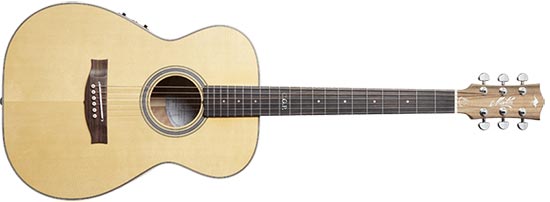
| Finish | Natural |
| Years Used | 2008 to Present |
Tommy’s second signature model, the TE Personal, bears more resemblance to the small, folky guitars of the New York folk boom than the dreadnaughts of Nashville country. This smaller six-string retails for around $8000 Australian.
The TE Personal is a higher-end instrument than the EBG808TE, made by hand at Maton HQ in Australia. It boasts several key differences from Emmanuel’s standard touring models, largely in choice of wood and finishes. This higher-quality instrument does not appear as part of Tommy Emmanuel’s touring lineup, as he likely does not want to expose this beautiful piece of work to the harsh touring environment.
The TE Personal features a AAA Grade Sitka Spruce top with Queensland maple back and sides, just like the EBG808. However, where the EBG808 has a Queensland maple neck, the Personal uses a mahogany neck, which will give this guitar a darker sound. Likewise, where the EBG808 has an ebony fretboard, the Personal’s fretboard is rosewood, and its fret wire is Dunlop 6260. This guitar is finished in satin rather than the lightly stained gloss finish of the EBG808 and has an optional pickguard. In fact, you can see in the video below that the model Tommy is playing lacks a pickguard entirely.
1930 Martin 0-17
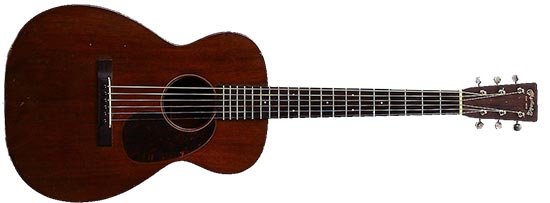
| Finish | Walnut |
| Years Used | 1996 to Present |
Tommy Emmanuel was not merely certified as a guitar player by the legendary picker Chet Atkins, but he was also gifted a pre-war Martin guitar by Atkins himself, and it became his main go to for quite some time before starting his partnership with Maton guitars. Tommy plays this 1930 Martin O-17, a small-bodied American-made guitar. Although Emmanuel remains steadfastly loyal to Maton for touring, he frequently records with guitars from other brands, including this priceless pre-war Martin guitar.
Martin’s Depression-era O series came about primarily due to necessity. As the American economic downturn strangled guitar sales, Martin had to make some accommodations to the diminished market. One of these was smaller-bodied guitars with necks meeting the body at the fourteenth fret, such as the O-17. These guitars were made from mahogany, for the back, sides, and top as well as the neck. This gave them a dark, throaty sound not dissimilar from folk instruments of the time such as the banjo or traditional Spanish-style guitars.
This 0-17 likely came to his hands sometime in the late 1990s when they were working together on Atkins’ final album. As Chet was Emmanuel’s guitar hero, this guitar doubtless holds significant sentimental value for him. He does not tour with this instrument, as its age and heritage, make it priceless and fragile. Pre-war Martin guitars are among the most valuable in the world, and although the O series, particularly the less-popular likes of the O-17, are less sought after than pre-war D-45s, for example, they still hold a relic status. This is easily one of the most iconic Tommy Emmanuel guitars of all time.
Popular Related Article: Australian Guitarists Angus Young and Malcolm Young guitar and gear list.
Larrivée C-03-TE Custom Tommy Emmanuel
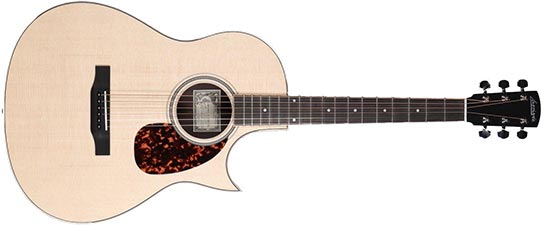
| Finish | Natural |
| Years Used | 2020 to Present |
In the late 1990s, Jean Larrivée built a custom C-10 model guitar for Tommy. The guitar was reportedly used in the studio by Tommy over the years and he has expressed how much he admires the guitar. In 2020 Larrivée guitars released a custom shop tribute to the original 12-fret acoustic guitar, the C-03R-TE Custom Tommy Emmanuel model.
1966 Fender Telecaster
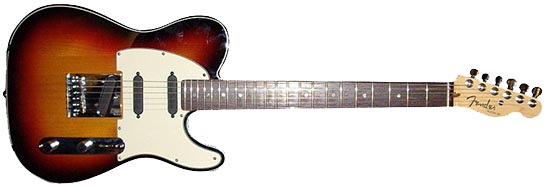
| Finish | Worn Sunburst |
| Years Used | Unspecified to Present |
Although Tommy Emmanuel is best known for his frightening acoustic guitar chops, he is an accomplished electric guitar player as well. Much of his early work as a session musician came thanks to his ability on an electric six-string. Tommy, like most country guitarists, was loyal to the Fender Telecaster, which he used during his time with Doug Parkinson, Tina Turner, and while touring as Dragon’s lead guitarist.
Emmanuel’s electric playing is no less physically demanding than his acoustic style, as is evident from the clear road wear on his 1966 Tele, as can be seen in the photo above.
The Fender Telecaster was, upon its debut in 1950, as revolutionary as Tommy Emmanuel’s playing. Although it was quickly commercially successful, Leo Fender, ever the tinkerer, insisted on refining his flagship guitar. As such, the 1967 Telecaster is similar to its 1950s brethren but does have some updates. The 1967 Telecaster removed the “dark circuit” from its neck pickup array, which had been a standard feature on earlier models. The tone control knob that is now standard on most electric guitars was an entirely new feature upon its introduction in 1952, allowing for a frequency sweep to control the darkness or brightness of the guitar’s sound. The ‘67 Telecaster was the first to feature, in its standard two-pickup configuration.
Tommy Emmanuel’s Telecaster, however, features a Stratocaster-like three-pickup configuration. Fender actually released a Tommy Emmanuel signature Telecaster based on his own instrument. This Tele featured Bartolini boutique pickups, built-in California under special orders.
Tommy’s 1966 Telecaster, and the signature models on which that was based, featured an alder body with a maple neck and rosewood fretboard. This was the thinner “veneer” style fingerboard, rather than the thicker “slab” style which predated it. It featured Kluson tuners on its smaller pre-CBS style headstock.
You can see Tommy paying tribute to George Harrison in the below video, in which he performs “With a Little Help From My Friends” on his Telecaster.
Popular Related Article: Chris Stapleton Guitar Rig
Timetable Showing Each Guitar Tommy Emmanuel Has Played Throughout His Career
| Make | Model | Color/Finish | Years |
|---|---|---|---|
| Fender | 1966 Telecaster | Worn Sunburst | Unspecified to Present |
| Martin | 1930 0-17 | Walnut | 1996 to Present |
| Maton | EBG808TE | Natural | 2008 to Present |
| Maton | TE1 Personal | Natural | 2008 to Present |
Tommy Emmanuel Amplifier Overview
Tommy Emmanuel, by his own admission, rarely uses much by way of a guitar rig. His acoustic performances, for example, typically include a sole amp and colorizer, with all of Tommy’s tonal variations coming from the man’s own fingers. He uses a signature amp from AER as well as AER’s colorizer, on the road, with as little else between the guitar and the speaker as possible. Let’s take a look at Tommy Emmanuel’s simple, yet effective, approach to guitar amps.
AER Compact 60 Emmanuel Signature
AER is a lesser-known German amplifier builder, at least when compared to the behemoth amp companies like Marshall and Vox. AER specializes in acoustic amplification technology, striving to replicate the natural tonal qualities of an unamplified acoustic, by simply making them louder. AER came into existence in the 1990s, around the height of the MTV Unplugged era, and quickly established a reputation among the finest acoustic guitar amplifiers in the world. Remarkably, AER’s amps are all still built in Germany, even three decades later, including their Tommy Emmanuel signature model.
Emmanuel relied heavily on AER Compact 60’s natural dynamic range and clear, articulate voice for much of his live acoustic guitar playing, and it’s no surprise that AER was happy to build him a signature amplifier. AER’s approach, like Tommy Emmanuel’s, is one where simplicity can be deceptive. Their neutrally voiced amps are small and light and feature simple, effective controls. The Compact 60, and the Tommy Emmanuel signature model, reflect this ethos, with a clear signal, minimal noise, and feedback, and a basic black-on-black color scheme that promises to let the music do the talking.
The AER Compact 60 Tommy Emmanuel signature model is, as the name suggests, compact, weighing only about 7.1kilos, or 15.6 pounds. Given Emmanuel’s ongoing penchant for touring in a van rather than a massive bus or private jet, one can understand his proclivity for space-saving gear.
Channel one has three band controls for its EQ, while channel two has two band tone controls for its EQ. There’s also a “Colour” knob that allows for a mid-cut or treble boost in Tommy’s tone. There is a digital effects processor built into the amp, typically controlled by Tommy Emmanuel’s guitar tech, with four preset controls, including the aforementioned custom effect. The other three channels are reverb and delay.
The AER Compact 60 Tommy Emmanuel model uses a 60W power amp, analog signal processing, and has an 8” twin-cone speaker for maximum sonic fidelity. Although Tommy Emmanuel rarely uses any external effects for his acoustic performances, this amp does boast a few nifty features for other players, including a headphone output, line out, pre/post effect switchable DI-out, external parallel effect loop, footswitch (internal/external effect on/off), and 3.5 mm aux-in jack socket, as well as tuner out.
AER Colourizer
Although this isn’t technically a full-fledged guitar amplifier, but rather a preamp, it forms a major part of Tommy Emmanuel’s live tone. Tommy runs his Maton guitars straight into the Colourizer via a Boss TU-3 tuner. The AER Colourizer is designed to provide a stronger, richer signal to an amplifier than the raw signal from a guitar alone. Although Tommy Emmanuel uses his for his acoustic playing, this little box similarly works well for vocalists looking to boost their microphone signal.
The Colourizer is part of AER’s Pocket Tools range. As with the rest of Emmanuel’s gear, it’s a diminutive, efficient processing unit about the size of a large effects pedal. It provides 15dB of cut and boosts with bandwidths from one octave to 1/6 octave, doing so at frequencies within either the lower range of 90Hz to 1.6kHz or from 680Hz to 11kHz.
Its “tone” section has even tighter control, with balance and intensity knobs allowing for fine-tuning of both bass and treble frequencies. As Tommy Emmanuel often fiddles with his guitar sound using the Maton EBG808’s onboard EQ, it’s unlikely that he messes with these settings live. However, the precise tone-shaping options afforded by the Colourizer are critical to the consistency of his live tone when he switches guitars.
Tommy Emanuel Pedals and Effects Overview
Boss SD-1
This is likely Emmanuel’s preferred overdrive tone, mainly used with his ‘66 Telecaster for any electric gigs. He mentioned using his Telecaster frequently for session gigs and live performances through the 1980s. Initially introduced in 1981 to compete with the Ibanez Tube Screamer and MXR Distortion + that, at the time, dominated the market for distortion stompboxes. The SD-1 has a distinctive, smooth sound thanks to its asymmetrical clipping circuit, which mimics the sound of a cranked tube amp at a lower volume.
Boss TU-3
Just like any other guitar player, Emmanuel is not exempt from the always necessary stage tuner, for this particular task he employs the always trusty, BOSS TU-3 tuner. He also uses this pedal’s signal-stopping feature to mute his guitars when switching from one to the next.
Wrap Up
Tommy Emmanuel’s prodigious ability proved to be a great success from the moment he set a foot on stage, as he rarely attended school, and instead lived on tour. Although the family eventually settled in Parkes, home of Australia’s own Elvis Presley Festival, Tommy kept on touring. He played alongside some of Australia’s finest country acts, as a session musician and honing his chops before eventually embarking on a highly successful solo career.
Emmanuel’s often-imitated, rarely perfected style often incorporates percussive as well as melodic techniques. He expanded on Atkins’ idea of Travis picking, playing bass, harmony, and melody on one instrument, and took it to another level. He often simulates the experience of an entire band with only his guitar, striking his Maton acoustics in various spots to achieve snare or kick drum sounds.
Now older and wiser, he remains one of the standing figures of Aussie music in the globe, and an exemplary artist that proves the quote “if its good on electric it can be even better on acoustic”. Furthermore, Emmanuel insists on the simplistic proverb of “practice makes perfection”, this being his only advice when asked for one, while modern age can see him as an underrated master, objectivity sets a just bar when his work comes to the spotlight, and leaves no room for doubt that this man is one of the greatest guitarists that ever lived.
In this article, we discuss Tommy Emmanuel’s most notable guitars and gear. Tommy’s expressive style of playing, perfected over decades, has earned him a well deserved devoted following.

My name is Chris and I’ve had a passion for music and guitars for as long as I can remember. I started this website with some of my friends who are musicians, music teachers, gear heads, and music enthusiasts so we could provide high-quality guitar and music-related content.
I’ve been playing guitar since I was 13 years old and am an avid collector. Amps, pedals, guitars, bass, drums, microphones, studio, and recording gear, I love it all.
I was born and raised in Western Pennsylvania. My background is in Electrical Engineering, earning a Bachelor’s degree from Youngstown State University. With my engineering experience, I’ve developed as a designer of guitar amplifiers and effects. A true passion of mine, I’ve designed, built, and repaired a wide range of guitar amps and electronics. Here at the Guitar Lobby, our aim is to share our passion for Music and gear with the rest of the music community.

Last time I saw him playing it was through a Da Capo 75 amp.
This isn’t the Tele described above: https://www.youtube.com/watch?v=s78WCIJD734